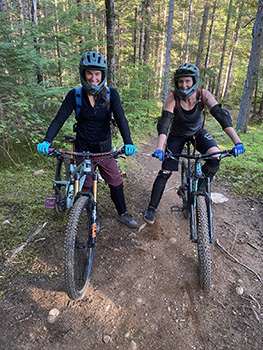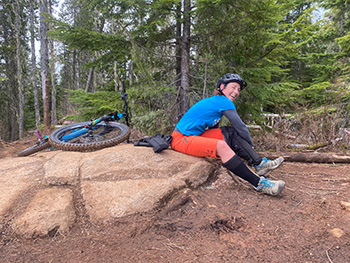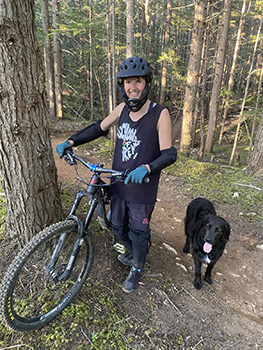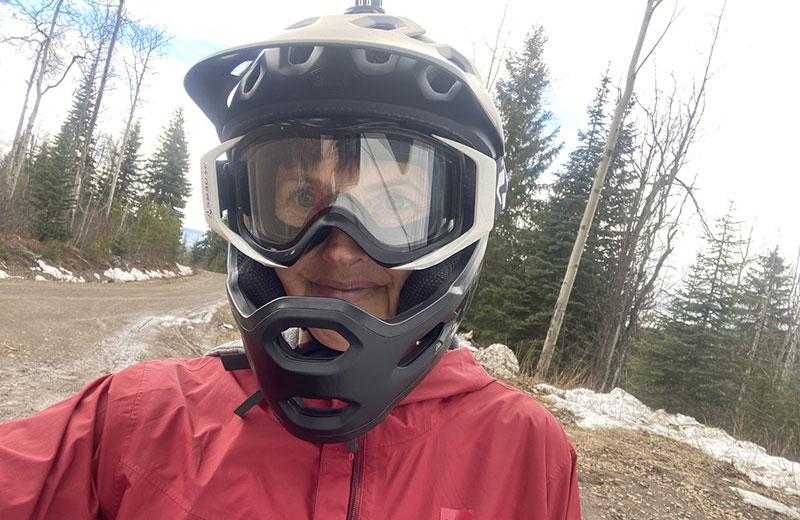Hogzilla. Terradise. Get Corked. Pump Daddy. Carcass.
Who could resist a sport with such fun trail names?
As communities develop more accessible trails across Northern BC, the popularity of mountain biking continues to rise.
No surprise – mountain biking is fun, thrilling, and good for the body, mind, and spirit. The wilderness and views you can enjoy from the trails are often breathtaking as well.
Mountain biking does come with risks, however. As the number of trails in communities increases, often so do the number of bikers showing up to the local emergency room.
Here are four tips to help protect yourself from serious injuries if you plan to pick up this sport:
Wear a full-face helmet

If you plan to ride anything more than the flat, easygoing green trails, buy a full-face helmet. A full-face, as opposed to an open-face helmet, has a jaw piece that protects your cheeks, jaw, and teeth in addition to the top of your head.
I didn’t wear a full-face helmet when I first started biking, even though I was riding difficult downhill trails. Silly me didn’t want to be a poser; I wasn’t as experienced a rider as the older men and women I biked with, so I didn’t think I was “worthy” of one.
Then, in my early 20s, while riding on the North Shore in North Vancouver, I fell off a log a few feet off the ground and smashed my face hard. I killed some nerves in one of my cheeks and could hardly speak for a couple weeks afterwards because my face was so swollen. I was lucky and so grateful I didn’t break my jaw or lose any teeth. It took me almost a month to fully recover, and it took me even longer to regain my confidence on the trails.
That accident shook me up, and wearing a full-face helmet afterwards helped me not feel as nervous about falling again.
Looking back, I should never have questioned whether I was a “good enough” rider to wear a full face. Everyone riding anything intermediate – which is most trails in BC! – should protect their heads and face as much as possible.
A good full-face helmet can be expensive, but as the saying goes in the bike community, your dentist bill will cost you ten times more.
Side note: Many people were reluctant to wear a full-face helmet in the past because they’re hot and sweaty while riding uphill on the trails. These days, though, you have the option to buy a full-face with a removeable jaw piece, so you can leave it off on the way up and breathe easily, then clip it on for the way down, when you really need it.
Armour up

Bikers sometimes look like they’re going to war, covered from head to toe in armour. Bike armour is protective gear that covers different parts of your body, and is mainly used for downhill biking as opposed to cross-country biking.
Different armour options include arm pads, elbow pads, leg pads, knee pads, chest protectors, gloves, goggles, and more.
As for wearing a full-face helmet, wearing armour give you better protection. It can also increase your confidence, giving you that extra boost to try something new or intimidating. And I can tell you from experience, it really does hurt much less if you’re wearing armour when you fall.
Don’t be a hero
The adrenaline rush mountain biking can give you is glorious. I love being slightly on the edge and pushing my limit.
A big reason mountain biking is so fun is because there are so many skills to learn and features to conquer: climbs, jumps, drops, rock slabs, steeps, corners, roots, log rides, playing with different speeds, and much more.
It’s easy to be gung-ho when you first start, but the consequences can be huge if you don’t build your skills carefully, some of which can take years to develop.
So don’t be a hero on your first ride. Take baby steps.
Get to know the trails
Recon a trail by hiking it before you ride it. The first time you ride it, get off your bike to look at tricky sections before you hit them. Ride behind someone who knows the trail and can warn you of any difficult features coming up.
Go with friends who are patient and encouraging, and willing to talk and walk you through difficult sections. Session features over and over until you can ride them.
Also, trails are different on any given day, depending on the weather, how many others have ridden the trail before you, new features, and much more. Just because you cruised down a trail with no problems the day before doesn’t mean it will be as smooth today.
More info

Most communities have an off-road cycling association that manages the local trails. Where I live, it’s TORCA (Terrace Off-Ride Cycling Association). (Props to this amazing group and all the volunteer trail builders in the area – they do amazing work!) Often these groups will organize evening or weekend courses, bike maintenance workshops, or fun events. Your local bike shop is also a great resource to find supports near you.
Money matters
Mountain biking can be an expensive sport. To save money, I peruse Kijiji, Craigslist, local buy and sell groups on Facebook, and thrift shops for used armour. But always buy your helmet new. You never know if the integrity of a used helmet has been damaged by a big fall.














Comments